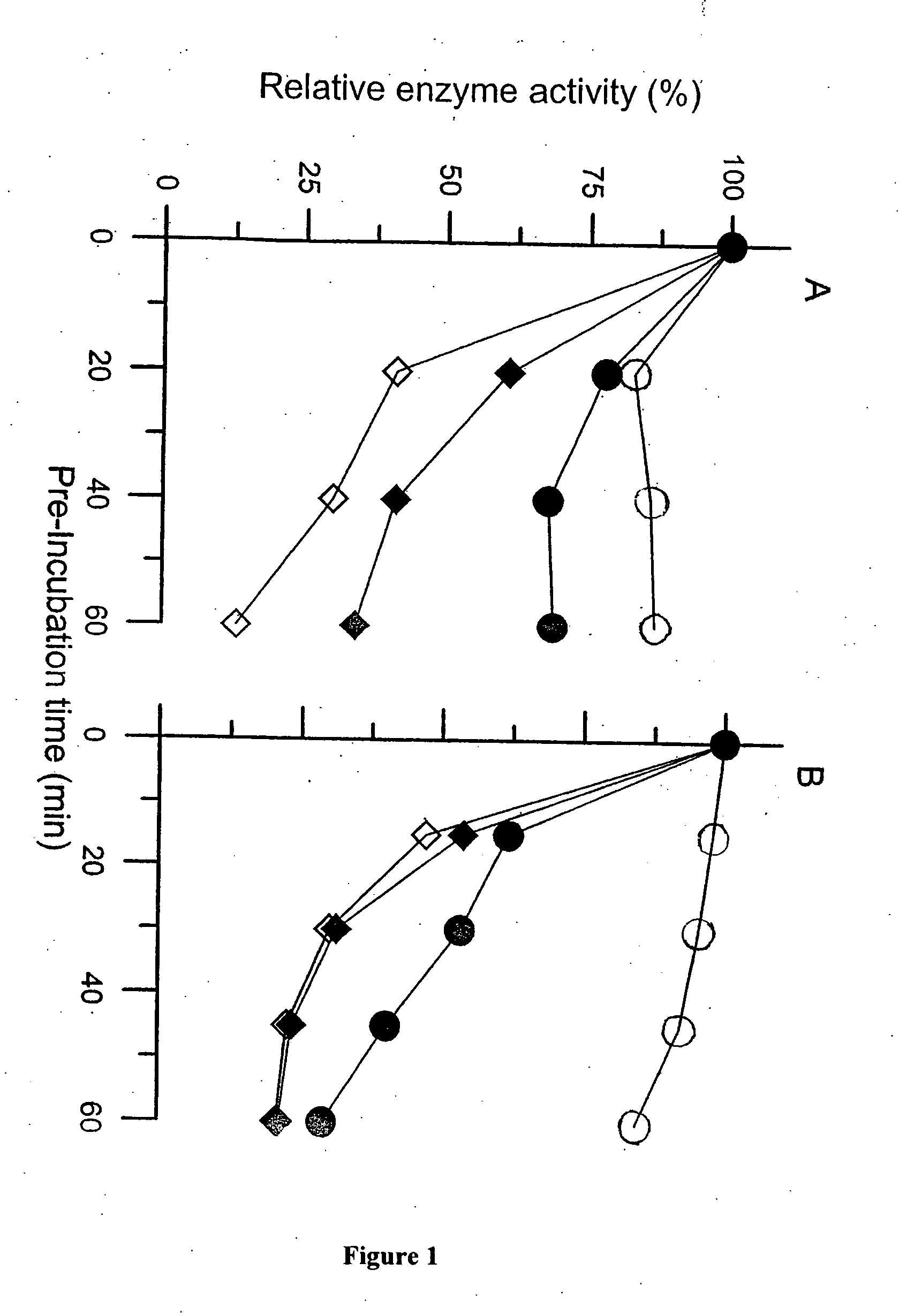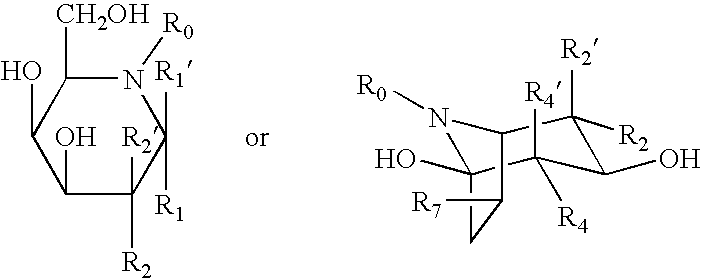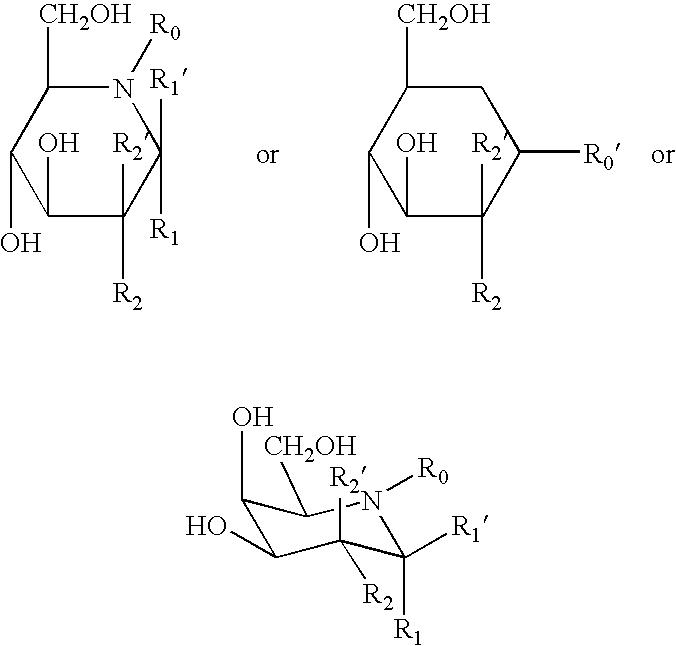Combination therapy for treating protein deficiency disorders
a protein deficiency and therapy technology, applied in the field of protein deficiency disorders, can solve the problems of inability of proteins vectors infecting or transducing dividing cells, and inability to cross the blood-brain barrier, etc., to achieve the effect of enhancing the stability of purified proteins
- Summary
- Abstract
- Description
- Claims
- Application Information
AI Technical Summary
Benefits of technology
Problems solved by technology
Method used
Image
Examples
example 1
In Vitro Stabilization of (α-Gal A With ASSCs
[0120] Methods. The wild type α-Gal A was purified from culture medium of Sf-9 cells infected with recombinant baculovirus carrying human wild type α-Gal A cDNA and the mutant α-Gal A was collected as homogenates of hearts of transgenic mice overexpressing human mutant (R301Q) α-Gal A. The mice were treated with 0.5 mM DGJ as drinking water for one week prior to the experiment. The mutant and wild type enzymes were pre-incubated with 0.1 M citrate-phosphate buffer (pH 7.0) at 37° C. for the mutant enzyme and 42° C. for the wild type enzyme, respectively, in the presence of DGJ at a concentration of 1 μM, 0.1 μM, 0.03 μM or no DGJ. The wild type and mutant (R301Q) α-Gal A were incubated for a period of time in the absence or presence of DGJ (various concentrations), and the remaining enzyme activity was determined with 4-MU-α-Gal A as a substrate, after diluting the mixture with 5-volume of 0.1 M citrate buffer (pH 4.5). Enzyme activity i...
example 2
Intracellular Enhancement of Wild-Type α-Gal A With ASSCs
[0122] Methods. Human wild type α-Gal A purified from insect cells transfected with recombinant baculovirus or from recombinant CHO cells can be conjugated to α-2-macroglobulin (α-2-M), according to the previous reference (Osada et al., Biochem Biophys Res Commun. 1993; 142: 100-6). Since the conjugate of α-Gal A from coffee beans and α-2-M can be internalized by cultured fibroblasts derived from Fabry hemizygotes, the conjugate of α-Gal A and α-2-M is expected to be internalized by the cells as well. Alternatively, the wild type α-Gal A can be added into the culture medium of skin fibroblasts derived from Fabry patient with no residual enzyme activity as described in Blom et al., Am J Hum Gen. 2003; 72: 23-31.
[0123] Results. The half-life of the coffee bean α-Gal A is about 2 hr as described previously (Osada et al., Biochem Biophys Res Commun. 1987;143: 954-8). It is expected that the half-life of the α-Gal A / α-2-M conjuga...
example 3
Co-Administration of DGJ to Fabry Mice Treated by Infusion of Replacement Enzyme
[0124] Enzyme replacement therapy for Fabry disease has been developed by Genzyme Corporation as described above. It is expected that co-administration of DGJ to Fabry knock-out (KO) mice treated by infusion of the replacement enzyme increases the stability, e.g., half-life of the replacement enzyme in vivo, because the ASSC DGJ stabilizes the enzyme and prevents degradation. DGJ is orally administered to the KO mice after infusion of the wild type α-Gal A according to the protocol described previously (Ioannu et al., Am J Hum Genet. 2001; 68:14-25). The α-Gal A activity in various tissues including heart, kidney, spleen, liver, and lung as well as serum is determined over a period of time, and compared with those from the control mice that do not receive DGJ, and mice that receive only DGJ but no enzyme. The extended time will indicate that co-administration of ASSC can improve the efficiency of enzyme...
PUM
| Property | Measurement | Unit |
|---|---|---|
| pH | aaaaa | aaaaa |
| concentration | aaaaa | aaaaa |
| diameters | aaaaa | aaaaa |
Abstract
Description
Claims
Application Information
 Login to View More
Login to View More - R&D
- Intellectual Property
- Life Sciences
- Materials
- Tech Scout
- Unparalleled Data Quality
- Higher Quality Content
- 60% Fewer Hallucinations
Browse by: Latest US Patents, China's latest patents, Technical Efficacy Thesaurus, Application Domain, Technology Topic, Popular Technical Reports.
© 2025 PatSnap. All rights reserved.Legal|Privacy policy|Modern Slavery Act Transparency Statement|Sitemap|About US| Contact US: help@patsnap.com



